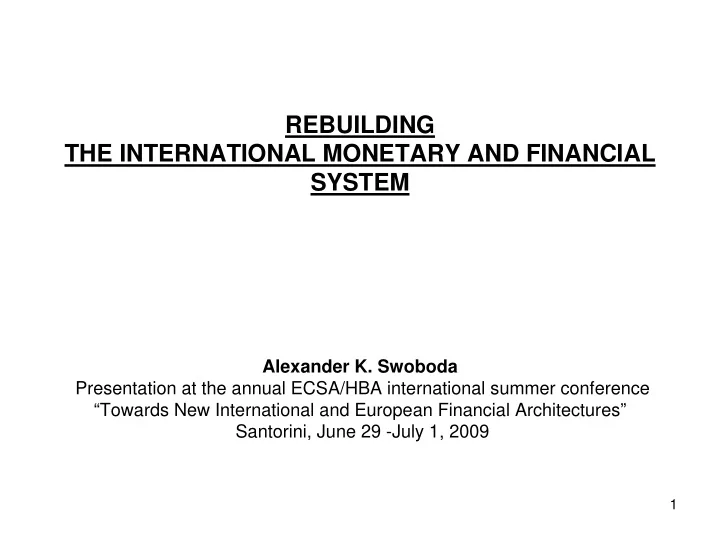

REBUILDING THE INTERNATIONAL MONETARY AND FINANCIAL SYSTEM Alexander K. Swoboda Presentation at the annual ECSA/HBA international summer conference “Towards New International and European Financial Architectures” Santorini, June 29 -July 1, 2009 1
Outline I. Introduction: both monetary and financial system II. Dimensions of the crisis III. Macro and micro origins IV. Short-run issues and measures V. Longer-run measures VI. Getting to the long run: Dealing with the legacy of the crisis 2
I. Introduction 1. Important characteristic of present crisis: link between monetary, financial and economic aspects 2. At fundamental level, a crisis of confidence 3
II. Dimensions of the crisis • Rising unemployment • Drying up of capital flows, notably to emerging markets (among others in Eastern and Central Europe) • Collapsing world trade • Weak and distant recovery • Negative world output growth for first time since WW2 • Failure to predict fall in output • Financial problems far from over 4
5 Source: IMF, WEO, April 2009
6 Source: IMF, WEO, April 2009
7 Source: IMF, WEO, April 2009
Output growth forecasts Source: IMF, WEO, April 2009 8
9 Output growth forecasts Source: IMF, WEO, April 2009
Output growth forecast Source: IMF, WEO, April 2009 10
IMF World Economic Outlook 2009 Growth Forecasts Actual Forecast April 08 Oct. 08 Jan. 09 April 09 Date 2007 World 3.8 3.0 0.5 -1.3 5.2 U.S. 0.6 0.1 -1.6 -2.8 2.0 Advanced 1.3 0.5 -2.0 -3.8 2.7 Emerging 6.6 6.1 3.3 1.6 8.3 CEE 4.3 3.4 -0.4 -3.7 5.4 CIS 6.5 5.7 -0.4 -5.1 8.6 11
Financial problems far from over: two indicators • Huge write-downs forecast for the financial industry as a consequence of the crisis. IMF GFSR estimates from start of crisis to 2010: -$2.7 trillion on U.S.-originated assets - $1.3 trillion on assets originated in other mature markets - total: more than $4 trillion, of which 2/3 will fall on banks and 1/3 on insurance companies, pension funds, hedge funds and other intermediaries. • Recapitalization needs for financial industry: - Market cap. of global banks down from $3.6 to $1.6 trillion - Depending on equity requirements, IMF estimates that a further $275-500 billion capital needed for U.S., 375-725 for Euro Area, 125-250 for UK and 100-225 for other mature Europe. In aggregate $875 billion-1.7 trillion of further recapitalization needed. 12
III. Macro and micro origins At macroeconomic level 1. The great moderation ( the great illusion?) 2. Bubbles, paper wealth and rising debt/income ratios 3. Loose monetary policy, low interest rates, Greenspan put, moral hazard, search for yield, leverage and disregard of risk 4. Global imbalances and financing of rising debt levels 13
14 The great moderation ( the great illusion?) Source: Wall Street Journal
At the microeconomic level: 1. Mispricing of risk 2. Corporate governance: weak and wrong incentives 3. Extreme opacity and lack of transparence of instruments and markets 4. Credit-Rating Agencies: inaccurate and conflicted 5. Supervision: lax and spotty 6. Regulation: inconsistent across sectors and pro-cyclical. 15
IV. Short-run issues and measures 1. Basic: need to downsize/deleverage financial/banking sector 2. But need to avoid financial meltdown, i.e. too brutal a de-leveraging of financial institutions -----explains quantitative easing and unconventional monetary policy 3. Also avoid too rapid reduction in debt/income ratios, particularly of household sector, lest consumption, investment and hence aggregate demand fall too heavily; explains expansionary fiscal policy. 4. But fiscal consolidation in medium run necessary… 16
V. Longer-run Measures Among multiplicity of proposals, concentrate on essentials: 1. Make prudential regulation anti rather than pro-cyclical. 2. Increase the number of policy instruments to match the number of targets of policy, lest policy makers become schizophrenic. In particular do not ask central banks to achieve price stability, capacity output and financial stability with the sole interest-rate instrument. 3. Design regulation so that it is incentive compatible with the goals it seeks to achieve. Too often, regulation has unintended consequences that are the opposite of their original aim. 4. Guard against negative international level spillovers through a modicum of international cooperation/coordination: - China, U.S., Europe example - Role of IMF and other fora, and reform thereof - And above all keep economies and trade open. 17
VI. Getting to the long run: Dealing with the legacy of the crisis 1. First task: reign in the expansion of central bank balance sheets resulting from Q.E. and consolidating fiscal positions. Issues: - timing and extent of fiscal and monetary tightening as well as their coordination - threat to the independence of central banks. 2. Public policy has attempted to bail out just about every economic actor (e.g. the consumer) and sector (e.g. car manufacturers), not just the banks and the financial sector. In the process an enormous amount of moral hazard is being built into the system. How that can be reduced will be a, if not the , major issue in re-regulating the economy while avoiding to over-regulate it. 18
HARD CHOICES Tight Regulation SOVIET SYSTEM ? F Caveat Full Emptor Protection u ? ? l l P BUSH/ GREENSPAN FREE BANKING Loose Regulation 19
By way of conclusion… • That raises the question of what “getting back to normal” means. Hopefully not to a world of bubbles, inappropriate regulation and macroeconomic policies and moral laxity. And probably to a world where the financial industry, though efficient, will be smaller, simpler and less volatile than in the past ten years. 20
Recommend
More recommend